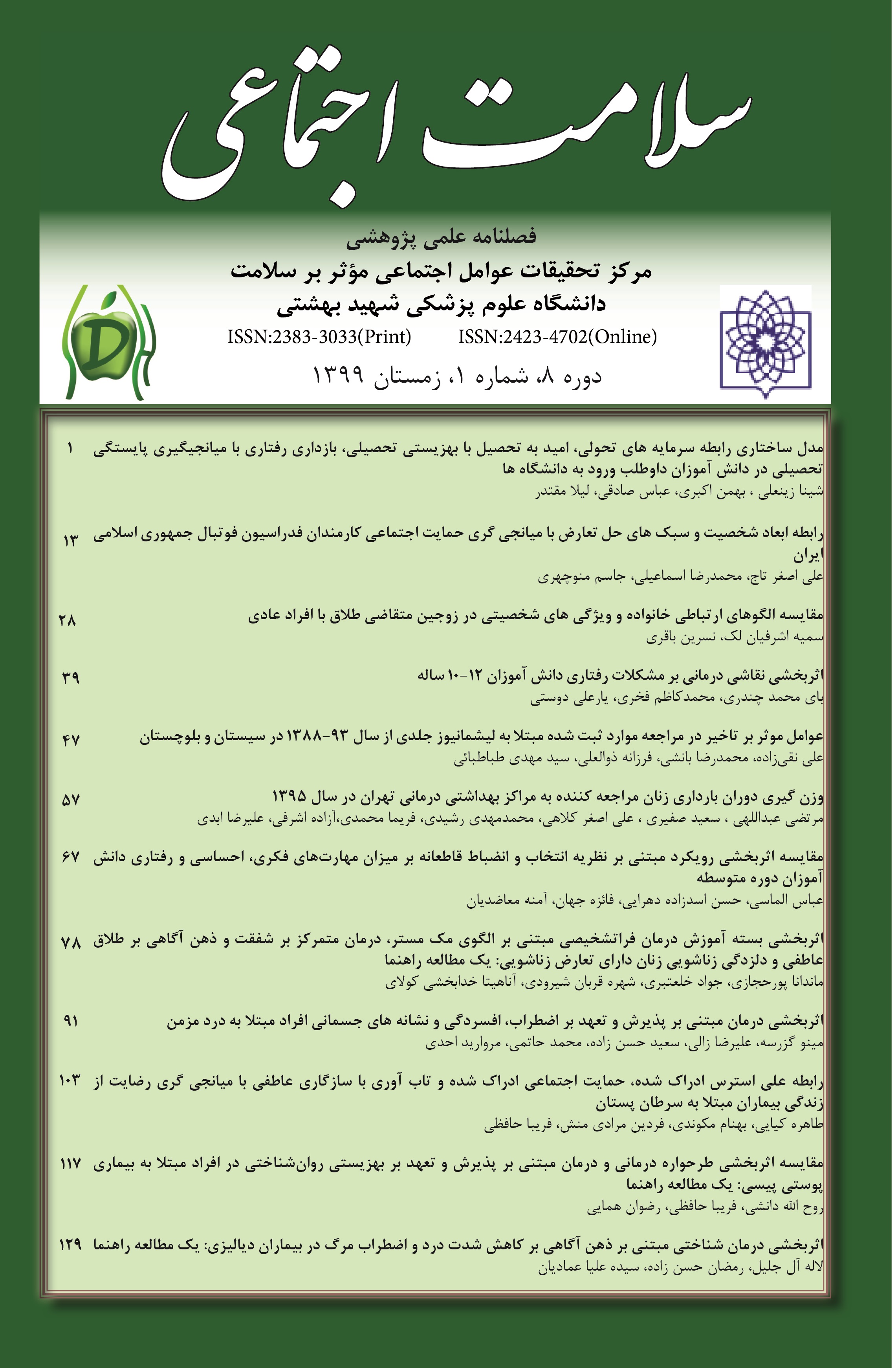تدوین و اعتباریابی بسته روانی- آموزشی مبتنی بر استعاره برای تبیین و مفهومسازی طرحوارههای حوزه گوش به زنگی بیش از حد و بازداری
سلامت اجتماعی,
دوره 9 شماره 4,
26 شهریور 2022
,
صفحه 24-37
https://doi.org/10.22037/ch.v9i4.31663
چکیده
زمینه و هدف: به دلیل بومی نبودن منابع اصلی روانشناسی یکی از چالشهای درمانگران ایرانی، نحوه ارائه مطالب و مداخلات روانشناختی به مراجعان است. طراحی و استفاده از استعارههای متناسب بافرهنگ و شرایط مراجع ایرانی به رفع این مسئله کمک میکند. این پژوهش با هدف طراحی و اعتبار یابی بسته روانی- آموزشی مبتنی بر استعاره برای تبیین و مفهومسازی طرحوارههای ناسازگار اولیه حوزه گوشبهزنگی بیشازحد و بازداری انجامشد.
روش و مواد: این پژوهش به صورت مطالعه کیفی و از نوع تحلیل محتوا با مشارکت 45 مراجعه کننده به دفتر فعالیت پژوهشگر در سال 1400 و 60 مشارکتکننده شبکههای اجتماعی در مقطع زمانی یکروزه انجام شد. روش نمونهگیری به صورت نمونه در دسترس بود. بر اساس مبانی طرحواره درمانی و بررسی کیفی استعارههای مراجعان و مشارکتکنندگان که محتوا و مضمونی طرحوارهای داشت، برای هر طرحواره حوزه گوشبهزنگی بیشازحد و بازداری پنج استعاره (درمجموع 20 استعاره) طراحی و تدوین شد و برای اعتباریابی در اختیار پنل متخصصان 13 نفری قرار داده شد تا علاوه بر روایی کیفی، روایی محتوایی به شیوه کمی نیز انجام شود. در اعتباریابی کمی از دو ضریب نسبی روایی محتوا و شاخص روایی محتوا استفاده شد.
یافته ها: از بین 20 استعاره طرحواره حوزه گوشبهزنگی بیشازحد و بازداری، 18 استعاره مقدار ضریب نسبی روایی محتوا و شاخص روایی محتوایی بالاتر از اندازه موردنیاز )54/0≤ CVR و 79/0≤ (CVI را به دست آورده و معتبر شناخته شد. برای کل بسته آموزشی مقدار ضریب نسبی روایی محتوا 88/0 و شاخص روایی محتوا 93/0 محاسبه شد.
نتیجهگیری: مطالعه نشان داد بسته روانی- آموزشی مبتنی بر استعاره طراحیشده برای تبیین و مفهومسازی طرحوارههای حوزه گوشبهزنگی بیشازحد و بازداری معتبر است.
- استعاره، طرحواره بدبینی/ منفی گرایی، طرحواره بازداری هیجانی، طرحواره معیارهای سختگیرانِ/ عیبجویی افراطی، طرحواره تنبیه
ارجاع به مقاله
مراجع
- Thibodeau, P. H., Matlock, T., & Flusberg, S. J. (2019). The role of metaphor in communication and thought. Language and Linguistics Compass, 13(5), e12327.
- Canal, P., Bischetti, L., Bertini, C., Ricci, I., Lecce, S., & Bambini, V. (2022). N400 differences between physical and mental metaphors: The role of Theories of Mind. Brain and Cognition, 161, 105879.
- Brekhus, W. H., & Ignatow, G. (2019). The Oxford handbook of cognitive sociology. Oxford University Press.
- Greenham, D. (2018). The Work of Metaphor: Ralph Waldo Emerson's" Circles" and Conceptual Metaphor Theory. ESQ: A Journal of Nineteenth-Century American Literature and Culture, 64(3), 402-434.
- Sullivan, K. (2018). Integrating constructional semantics and conceptual metaphor. MetaNet, 100, 11.
- Barton, G., Brömdal, A., Burke, K., Fanshawe, M., Farwell, V., Larsen, E., & Pillay, Y. (2022). Publishing in the academy: An arts-based, metaphorical reflection towards self-care. The Australian Educational Researcher, 1-22.
- Flotman, A.-P., & Barnard, A. (2022). THE EVOLUTION OF PERSONAL FRAMES OF REFERENCE: METAPHORS AS POTENTIAL SPACE. International Journal of Doctoral Studies, 17.
- Rosenhan, C., & Galloway, N. (2019). Creativity, self-reflection and subversion: Poetry writing for Global Englishes awareness raising. System, 84, 1-13.
- Verovšek, P. J. (2019). Social criticism as medical diagnosis? On the role of social pathology and crisis within critical theory. Thesis Eleven, 155(1), 109-126.
- Csatár, P. (2022). Extended conceptual metaphor theory. Acta Linguistica Academica.
- Torres-Martínez, S. (2022). Metaphors are embodied otherwise they would not be metaphors. Linguistics Vanguard.
- Al-Khaza’leh, B. A., & Alzubi, A. A. F. (2022). The Metaphorical Conceptualization of Love in English and Arabic Songs: A Contrastive Study. Theory and Practice in Language Studies, 12(6), 1189-1199.
- Forgács, B. (2022). The pragmatic functions of metaphorical language. In A Life in Cognition (pp. 41-57). Springer.
- Kopp, R. R. (1995). Metaphor therapy: Using client-generated metaphors in psychotherapy. Brunner/Mazel.
- Aboutalebi Karkavand, Azadeh, & Marzieh Kazemi Rashenani. "The Role of Metaphors in New Psychology Approaches." (2021) Tehran: Khat-e Akhar Publications.
- Van der Hart, Onno. Witztum, Ely & Friedman, Barbara. (1988). The use of metaphor in psychotherapy. Journal of Contemporary Psychotherapy.
- Ervas, Francesca; Grazia Rossi, Maria, Ojha, Amitash; Bipin Indurkhya. The Double Framing Effect of Emotive Metaphors in Argumentation. Frontiers in Psychology | www.frontiersin.org. published: 14 June 2021. doi: 10.3389/fpsyg.2021.628460
- Törneke, Niklas. Metaphor in Practice: A Professional's Guide to Using the Science of Language in Psychotherapy. Translated by Mitra Moslehi Juibari and Mehdi Purasghar Arabi (2021). Tehran: Arjmand Publications.
- Stott, R. Mansell, W. Salkovskis Paul M. Lavender, A. Cartwright-Hatton, S. (2010). Oxford Guide to Metaphors in CBT: Building Cognitive Bridges. Oxford University Press
- Mathieson, F. (2019). Metaphor in Cognitive Behaviour Therapy (Thesis, Doctor of Philosophy). University of Otago. Retrieved from http://hdl.handle.net/10523/9720
- Cameron. L ,Metaphor in Educational Discourse [Advances in Applied Linguistics] London & New York:Continuum ,2003 0-8264-4940-9
- Angus, L. E., & Rennie, D. L. (1989). Envisioning the representational world: The client's experience of metaphoric expression in psychotherapy. Psychotherapy: Theory, Research, Practice, Training, 26(3), 372–379.
- Butler, G., Fennell, M., Hackmann, A. (2008). Cognitive behavioral therapy for anxiety disorders. New York: Guilford.
- Padesky, C. (1991). Schema as self-prejudice. International Cognitive Therapy .Newsletter, 6, 6-7.
- Young, Jeffrey, Janet Klosko, Weishaar Majorie. Schema Therapy: A Practitioner's Guide. Translated by Hassan Hamidpour and Zahra Andouz (2015). Tehran: Arjmand Publications.
- Arntz, Arnoud, and Gitta Jacob. (2013) Schema Therapy in Practice: An Introductory Guide to the Schema Mode Approach. Translated by Hamed Barabadi (2019). Tehran: Asbar publications.
- Stevens, Bruce, and Eckhard Roediger. Breaking Negative Relationship Patterns: A Schema Therapy Self-help and Support Book. Translated by Adele Samimi, Sa'adeh Malekasgar, and Maryam Hedayati (2020). Tehran: Arjmand Publications.
- Habibi, Arash, and Maryam Adanpour (2017). Structural Equations Modelling and Factor Analysis. Tehran: Jahad Daneshgahi Press. Sixth Edition.
- چکیده مشاهده شده: 134 بار
- pdf دانلود شده: 80 بار
